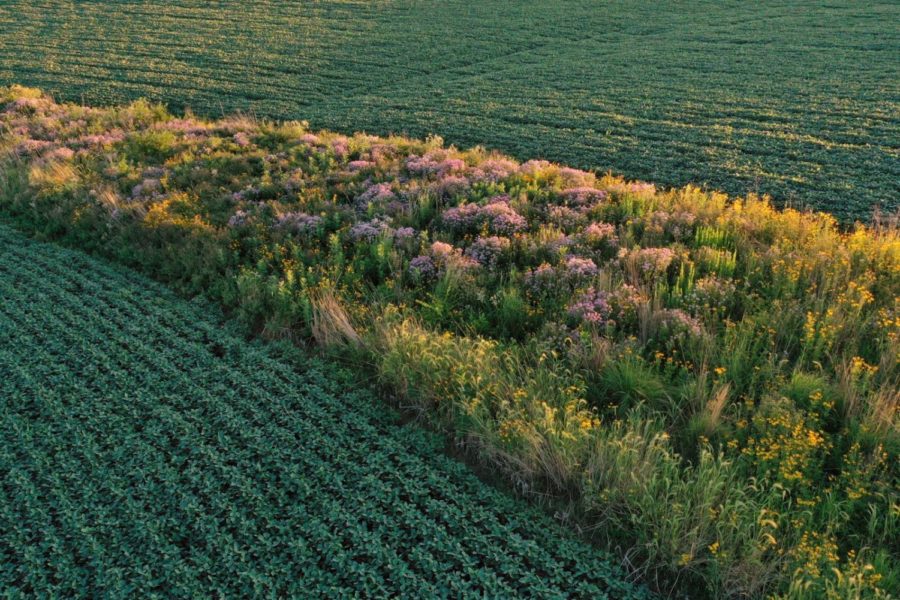Iowa State receives a $1.1 million grant to enhance prairie strip project
February 8, 2021
Editor’s note: This story has been updated to properly display the data collected for STRIPS.
Iowa State University, best known for science, technology and agriculture, partnered with a West Coast firm to help fast track farmland conservation practices known as prairie strips.
The Iowa State University Foundation received a $1.1 million ($1,104,788) grant from the Bia-Echo Foundation of Palo Alto, California, that will be distributed over three years. The project expands on existing development administered by the Science-based Trials of Row-crops Integrated with Prairie Strips (STRIPS) project.
Lisa Schulte Moore, professor in the department of natural resource ecology and management, developed this idea for STRIPS with several colleagues over 15 years ago and it has grown since.
Corn and beans are the basis of Iowa’s economy but they come with a cost to the environment.
Research found interlacing parts of prairie into key agricultural fields at a rate of 10 percent can benefit habitats, reducing greenhouse gas emissions, saving soil and water quality, Moore said.
“We are looking at prairie, which built the world-renowned fertile soils here in Iowa [and] we are integrating it back in to regenerate our soils for now and into the future,” she said.
Bia-Echo Foundation’s mission is to help create an equitable society by accelerating social change for generations to come. The foundation invests in reproductive longevity and equality, criminal justice reform and a healthy, livable planet.
Bia-Echo was founded by Nicole Shanahan, according to their website, and it partners with individuals and organizations with advanced ideas and solutions to accelerate the impact of their groundbreaking work.
This is exactly what Rep. Ro Khanna of California’s 17th District found in Iowa State’s prairie strip research. While Khanna represents the home of Silicon Valley, he currently works to create new tech jobs across America by connecting the digital revolution on the East Coast with the agriculture industry among others.
Khanna sits on the House of Agriculture Committee and facilitated in getting the grant for Iowa State. He focuses on creating new job centers in areas of the country often left out of the digital revolution, like rural Iowa.
Khanna said he hopes to see more partner work between tech and public universities and community colleges such as Iowa State and Des Moines Area College.
“We need to make sure more communities are part of the digital revolution — the technology revolution — [and] that young people have the opportunity to create new digital wealth, to do jobs in the digital economy wherever they are,” Khanna said.
Moore said they worked very closely with farmland and farmers to make the transition from a research project to an operational conservation practice on farms. Khanna said he hopes to see farmers paid for adopting environmentally friendly farming practices.
In 2018, prairie strips were added to the farm bill as a Conservation Reserve Practice (CRP), allowing for farmers to receive assistance to put prairie strips on their farmland.
Farmers were 47 percent more willing to put prairie strips on their fields if they can get the federal payment to help with costs, Moore said. Khanna also said tax and federal government incentives should be implemented to better include rural communities.
Their project has caught the attention of commercial farmers and Moore said even though prairie stripping is being used on a larger scale, the results are consistent.
As of Dec. 30, 2020, there are 9,251 acres of CP-43 prairie strips in 13 states: 4,389 in Illinois, 279 in Indiana, 3,130 in Iowa, 253 in Kansas, 12 in Michigan, 692 in Minnesota, 3 in Mississippi, 240 in Nebraska, 3 in North Dakota, 54 in Ohio, 114 in South Dakota, 8 in Wisconsin, according to STRIPS Project Coordinator Omar de Kok-Mercado.
Only Khanna’s goals stretch bigger than creating jobs, they also include tackling climate change.
“Prairie strippers are farmers, it is not people sitting in Silicon Valley,” Khanna said. “So what we need to do is harness the expertise and knowledge of people in the local communities, the expertise of farmers can help solve climate change.”
Khanna and Moore stressed agriculture has great impacts on the environment and the economy, so sustainability is key.
“Soil is the foundation of all agriculture and we all need it not only today but for future generations,” Moore said. “They are going to need soil to sustain civilization, because it really is just the basis of so much wealth, we need to protect our soil.”







